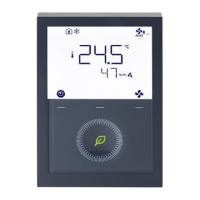*) If P027 = ON, electric heater in cooling mode.
Either floor temperature sensor or external room temperature sensor can be used.
This function increases the comfort in the room by keeping the supply air
temperature of the fan coil unit between the selected minimum and maximum
temperature limits.
If the supply air temperature exceeds a limit, the thermostat reduces the
corresponding valve position until the supply air temperature is back in the limits.
In case the air flow is too low (especially with DC 0...10 V fans), this prevents cold
air from dumping into the room/warm air from bubbling straight up instead of
circulating.
To enable this function, the multifunctional input, to which the supply air sensor is
connected, needs to be set to "Supply air sensor" (e.g., P150 = 9). Then the
parameters for the limits are displayed (P063: minimum supply air temperature,
P064: maximum supply air temperature).
● This function is only active in Comfort mode when:
– Valve output type is 3-position (RDG20..) or DC 0...10 V (RDG26..)
– Electric heater is PWM / 3-position (RDG20..) or DC 0...10 V (RDG26..)
● This function can not be used for radiators.
● This function can not be used in 4-pipe with 6-port ball valve application.
Set different limits to the flow in both sequences, heating and cooling to balance
heating and cooling systems and avoid hydraulic problems caused by the different
flow rates.
Cooling typically requires a higher flow rate than heating, and generally the combi
valve (PICV) is mechanically and manually set to the cooling flow limit.
However, when the system operates in heating mode, another flow limitation is
requested.
Tools can independently adjust the new maximal water flow limits for heating and
cooling (new valve positions, by 100 % heating and cooling demand), by limiting
DC 0…10 V signals via parameters P260 (heating) and P261 (cooling).
The adjusted parameters can be easily downloaded to thermostats using the
smartphone app PCT go with the NFC technology. This avoids complex
procedures for mechanically adjusting the limits, i.e. directly on the valves.

